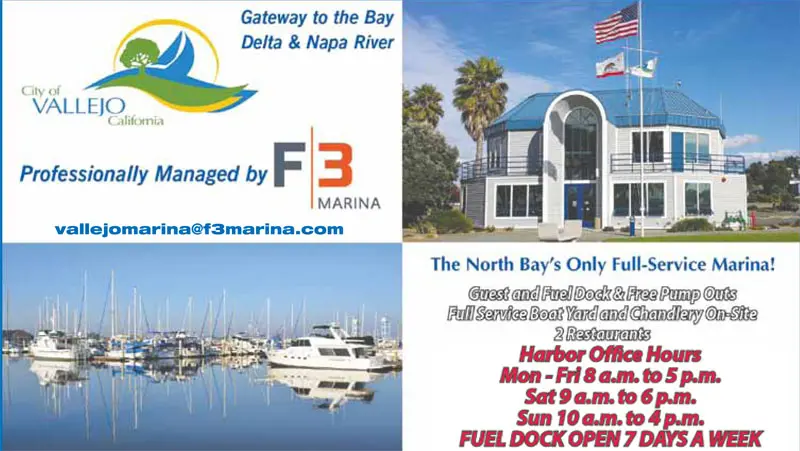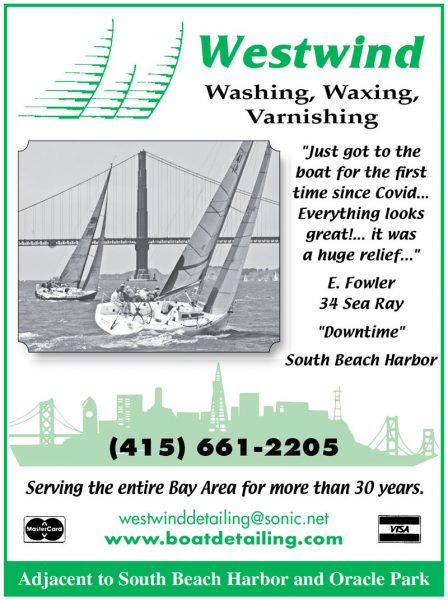
- Racing
- International Racing
- Current News
- Events
- West Coast Sailing
- Northern California Racing
- Wings & Foils
SailGP Rewards “the Best Sailors in the World”
On one of most bizarre weather days in recent memory on San Francisco Bay, the Mubadala SailGP showcased its Season 2 finale in front of thousands of enthusiastic sailing fans who lined the shore from Crissy Field to the Golden Gate Yacht Club. Unfortunately, due to freakish winds out of the south, most of the action was far away from those who packed the stands and the adjacent host yacht clubs.
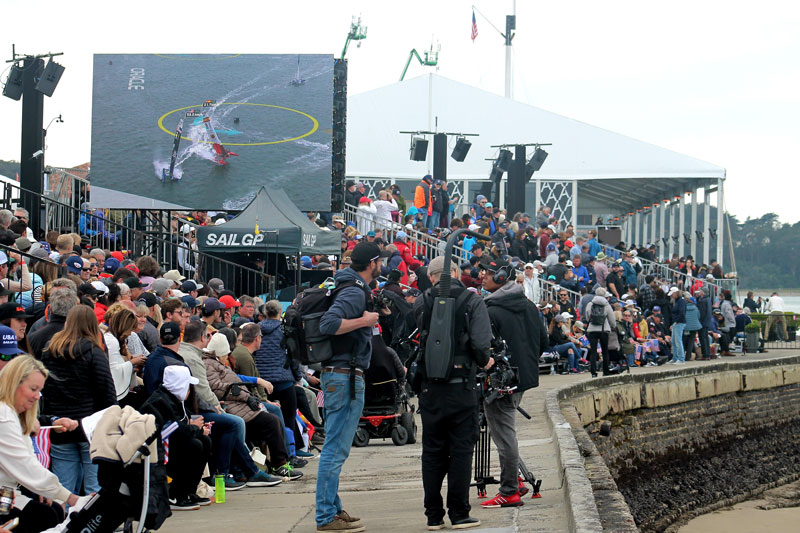
Saturday’s Racing
Saturday wasn’t ideal for Team USA, as Spithill admitted. “We made a lot of mistakes out there, to be honest, but for us the focus is that we take the lessons from today and make sure the F50 is in one piece for that last race, and then put the throttle down.” Unfortunately, that didn’t happen.
Slingsby, known by his competitors as “the red mist” for his volatile intensity, threw a little fuel on the barbie, stating that, “I’ve heard on the grapevine that the US team is trying new things, but if I was them, I would cancel those plans and get back to what they know, because they didn’t look too good.”
Sunday’s Races and the SailGP Grand Finale
A wayward whale, likely making its voyage home, threw a wrench into the podium finale, but it served as a reminder of one of SailGP’s pillar purposes, its Impact League and our responsibilities as custodians of our increasingly fragile planet.
“When they spotted the whale [during the podium race], I thought we were being punked! Is this a joke or what?” said Slingsby. “It’s good for us. We know as soon as the pressure’s on we’re going to be hard to beat. We perform better when the pressure’s on.”
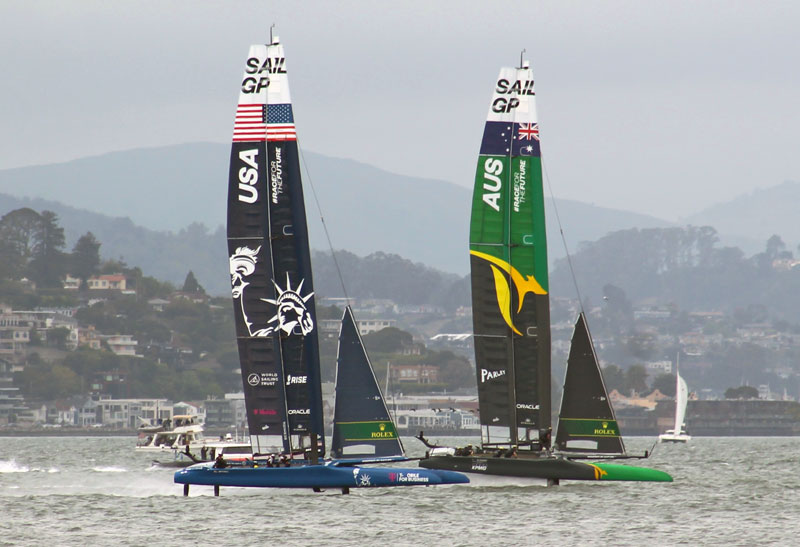
Just in the nick of time before a much-needed rain storm swept through, Tom Slingsby and his Australian Team received that million-dollar check, having won the season championship for a second straight season. Team Japan, skippered by Nathan Outteridge, came in second, and Team USA’s Jimmy Spithill limped home third, doing all he could do to keep his boat afloat after an unfortunate collision with the Spanish boat in Sunday’s first race.
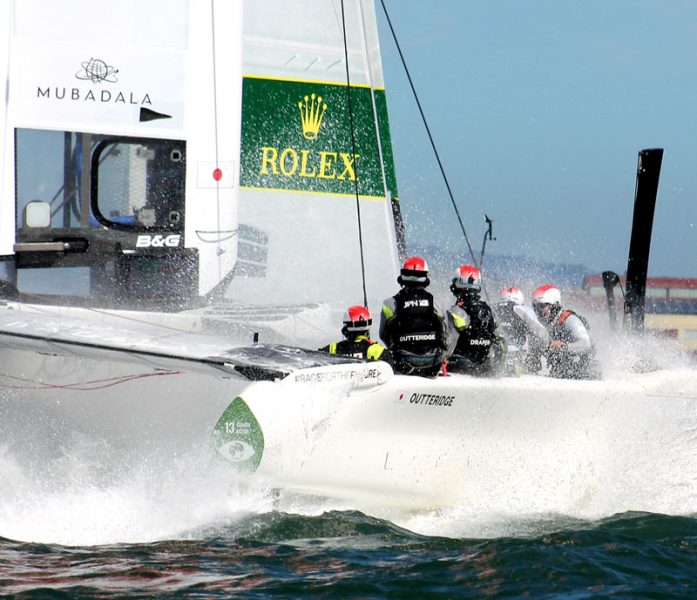
“If it’s the America’s Cup, they’ve got different designs and one boat’s faster than the other, but to be here with all even boats and Australia came out on top, we can call ourselves the best sailors in the world,” said Slingsby. “That’s more important than the money, that’s more important than anything, that we can say we’re the best sailors in the world. Money comes and goes but glory lasts forever. We really feel it is like that!”
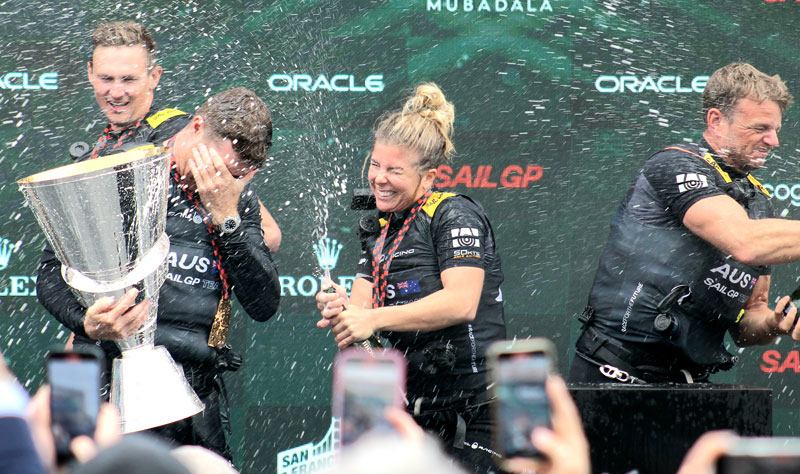
This wasn’t the weekend that Spithill expected. Least of all the un-San Francisco-like weather! “At the end of the day you really have to credit the Aussies. They have been the benchmark team all season, and to do it back-to-back, it’s very impressive. They deserve the win,” said Spithill. “I think Tom got off the line well. I think we were going to get off pretty well. We thought at one of the top line gates we were going to have a shot.”
The much-anticipated final race started with Team USA taking the early lead, but the race was abandoned after the whale was sighted on the course. In line with SailGP’s policy to protect marine life, racing was halted for 15 minutes. In the restarted race, Australia dominated, managing to find an area of better pressure on the racecourse. The Aussies opened up an early lead and never relinquished it as the teams battled increasingly difficult conditions and patchy wind.
The Fateful Collision
The first race of the day had sealed the Americans’ fate. Spain, with their untested helmsman Jordi Xammer, collided with Spithill, climbing up the side of the Team USA’s brilliant blue hull as they forced their way inside the Americans at the leeward gate. The Spanish team’s curved hydrofoil slid under, and then sliced a large hole in the sealed back end of the US boat. The team narrowly avoided serious damage. Flight controller Rome Kirby had to jump out of the way of Spain’s red hull.
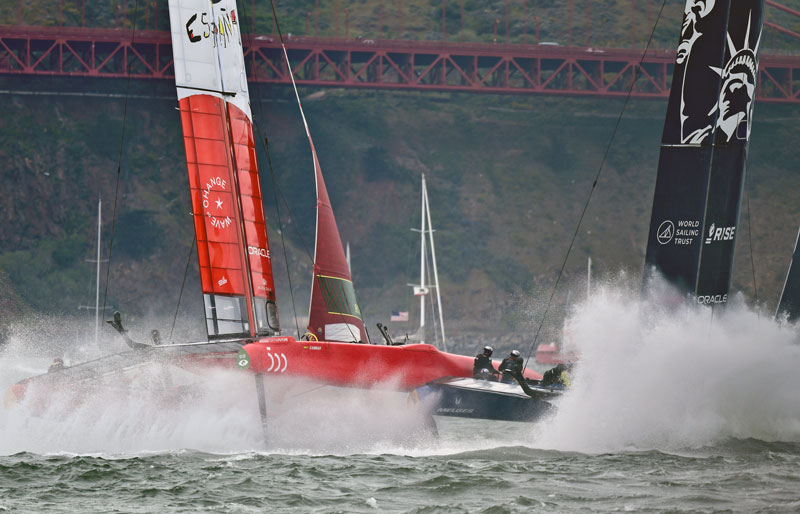
Spithill did not even flinch as the shore team quickly assessed damage and replaced the rudder. They sat out Race 5 to complete the repairs with an eye to compete in the final, while more action unfolded and another collision happened between France and New Zealand.
“The collision wasn’t ideal, that’s for sure, but the main thing is everyone walked away and there were no injuries. We were able to do repairs,” said Spithill.
Shifty, Puffy Winds
On a day when the wind gods confirmed SailGP CEO Russell Coutts and regatta director Iain Murray’s worst fears and presented an enormous challenge, Coutts summed it up by saying, “You couldn’t have asked for a worse day!” The weather did a turnaround. A strong westerly wind that was blowing straight down the course from the Golden Gate Bridge gave way to an unreliable southerly.
In the final race (take 2), Slingsby dominated the start and then found a gust of wind, powering Australia to a massive lead at the first mark. By then it was over. They clinched the million-dollar prize to be shared by the six sailors on the winning boat and their support staff. “We’ve been through a lot of things,” said Slingsby. “Four out of the six [Australian] sailing team were part of the 8-1 [America’s Cup] comeback here in 2013, and a lot of people talk about Jimmy [Spithill, skipper of Oracle Team USA in that extraordinary 34th America’s Cup victory], how Jimmy had this amazing comeback on San Francisco waters, but no one realized that four out of our six sailors were actually part of that.
“I just know that with my team, if things are going against us, we’re never going to give up. We’ve proven it time and time again, and I have faith and confidence in our team,” said Slingsby. “It’s amazing!”
Impact League
In the day’s other historic milestone, Peter Burling and Blair Tuke’s New Zealand team claimed the top prize in SailGP’s inaugural Impact League, presented by marine biologist Dr. Sylvia Earle. At SailGP, athletes race for two podiums, one for sport and one for the planet. The trophy is made from carbon fiber and depicts the Earth balancing precariously on top to represent the fragility of the planet. The New Zealand co-CEOs Burling and Tuke collected $100,000 for their Race for the Future Partner, Live Ocean. The money will go toward funding partner research into kelp forests and their potential to sequester carbon.
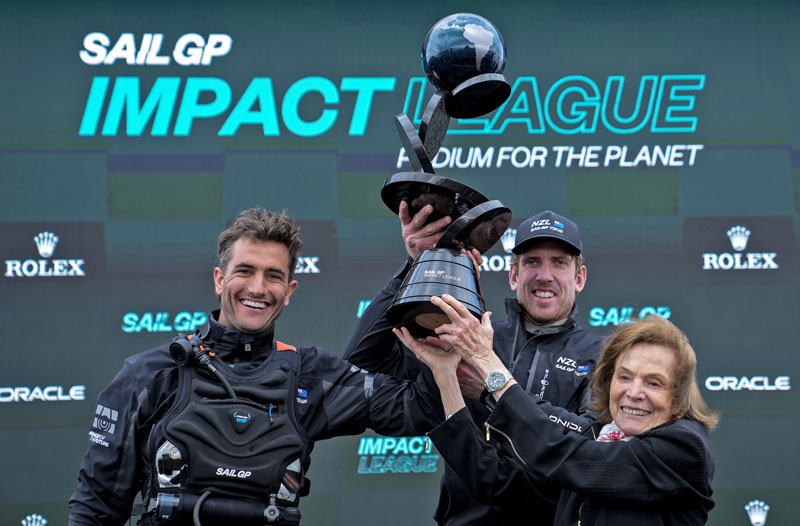
“We’re stoked to win the first Impact League,” said Burling. “It’s been a massive team effort from everyone involved, from the shore team, the sailing team, management and our partners.
Tuke added, “Increasing awareness of the vital role a healthy ocean plays in a healthy future has been a massive focus for us this season, so it’s awesome that the Impact League victory will enable us to support this important work by the University of Auckland through our partnership with Live Ocean Foundation.”
See www.sailgp.com for more.
Kenichi Horie Sets Sail Aboard ‘Suntory Mermaid III’
On Saturday morning the compact, 5-ft frame of 83-year-old Kenichi Horie bade farewell to a small crowd of well-wishers and mostly-Japanese media who gathered to see him ahead of his intended 6,000-mile/70-day voyage from San Francisco to Japan. It couldn’t have been a nicer morning on the docks of event host San Francisco Yacht Club, which has hosted Kenichi in the past, and which he considers his ‘lucky’ club for his voyages.
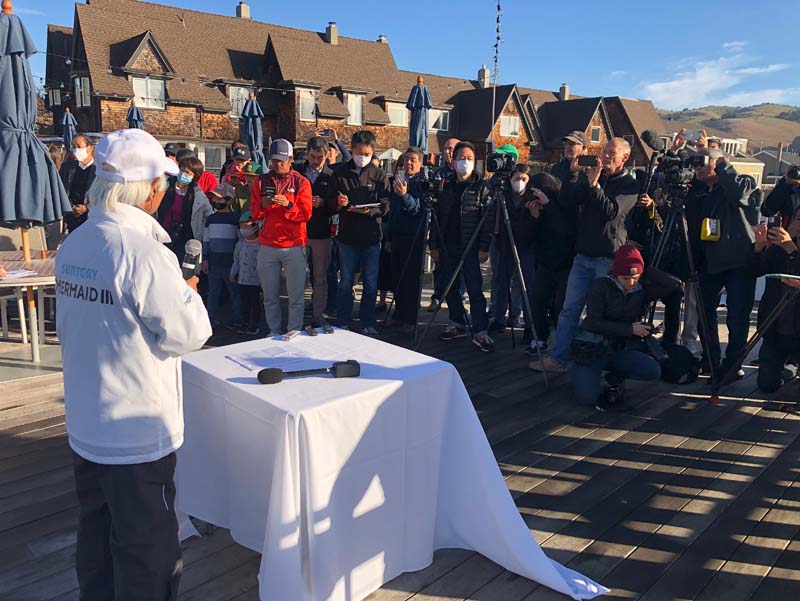
His unique, purpose-built 19-ft aluminum cutter is designed specifically for this voyage and for its skipper, Kenichi Horie. The boat is cutter-rigged with two roller-furling headsails, a windvane and modern GPS navigation, though he also carries a sextant as he did on his first voyage in 1962.
While the boat is much more modern and robust than his first Mermaid, Kenichi’s sailing style and plans retain an essential simplicity. He does not carry a watermaker. Instead he has 70 2-liter bottles of water, and also a beer for each day. The boat has no engine and has a solar panel for power. When asked about what he does at night he simply said, “I go to sleep.” He brings some books to read and a radio to listen to on the crossing. And when asked why he was going from San Francisco to Japan rather than Japan to San Francisco again, he said, “Because it’s warmer. On the Japan-to-San Francisco route you have to go north of the Pacific High, which is cold, and I want to wear a T-shirt. I will sail about two miles south of Hawaii, so it will be warmer.”
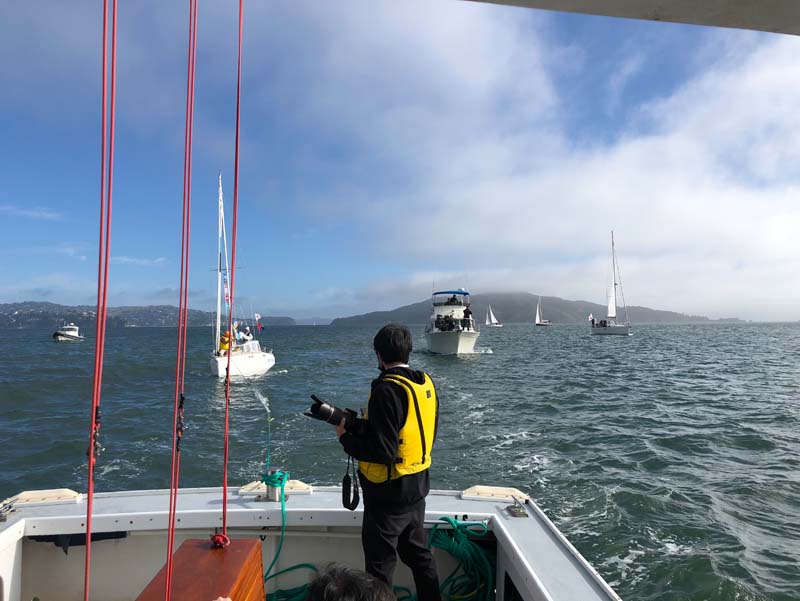
Just before 10 a.m., with a nice breeze and strong ebb, we cast off Suntory Mermaid III. Kenichi had a couple of handlers aboard to help raise sails and get things settled, and after a very short sail, he came alongside the Victory to drop them off. Kenichi then unfurled the jib and got the boat trimmed, and Suntory Mermaid III fell into her own groove, traveling at around 5+ knots upwind to the open Pacific. Naturally, there was a large tanker arriving, so Kenichi had to hold over toward the San Francisco shore to let the tanker pass before heading back to the middle of the ebb and the magic carpet ride out toward Point Bonita.
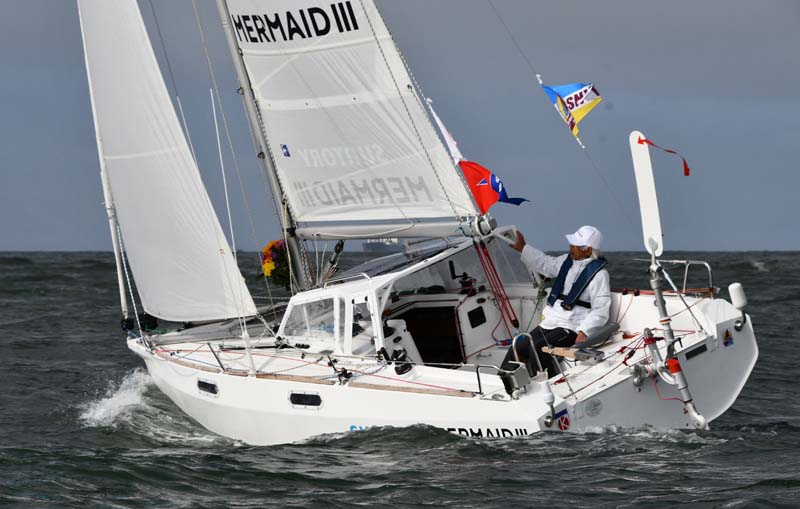
His calm demeanor, the comfortable-looking sailing, a well-equipped boat and his smiling wave made the whole proposition look entirely reasonable. To spend 70 days alone on a 19-ft boat thousands of miles from land certainly takes a difficult-for-most-to-achieve mental and emotional attitude. Still, 70 days is less than half the 148 days he was solo aboard a solar-powered, recycled aluminum boat with which he set the record for the fastest Pacific crossing of 10,000 miles in a solar-powered boat.
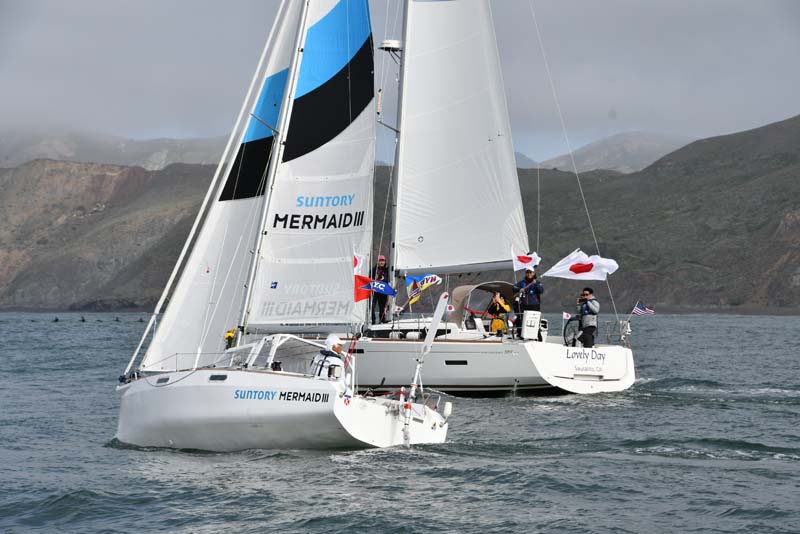
This is Kenichi’s eleventh major voyage. While he is understated and humorous when speaking, he’s not inattentive to the records he’s setting and the message he’s communicating. After setting the record at age 23 for being the youngest person to solo sail from Japan to San Francisco, he’s happy to now be setting the record for the oldest person to do the same course in reverse. He also wants to demonstrate the idea of simplicity and treading lightly on the planet. Each of his voyages has highlighted ecological possibilities such as crossing the Pacific in a catamaran made of beer kegs, pedaling from Hawaii to Japan (he said that was too much work!). He also sailed in a boat made primarily of recycled whiskey barrels — and the list goes on. He’s small in frame but carries a big message and belief in the need for a circular economy where nothing is wasted and everything is reused.
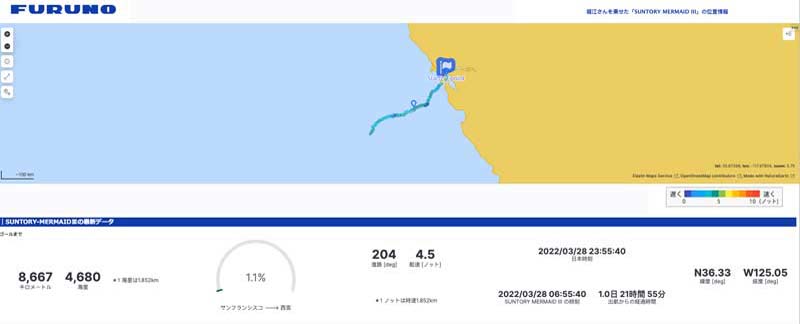
To follow Kenichi Horie you can click here. You will see a blue box like the one below. Click that. Though it’s all in Japanese, you should be able to follow along.

In his keep-it-simple approach, Kenichi says he doesn’t have any particular training regimen ahead of his voyages, and for food he carries mostly corn flakes and rice. If all goes according to plan he’ll be averaging about 3.5 knots across the Pacific, but we get the sense he’s in no rush and is just as happy to be at sea as ashore.
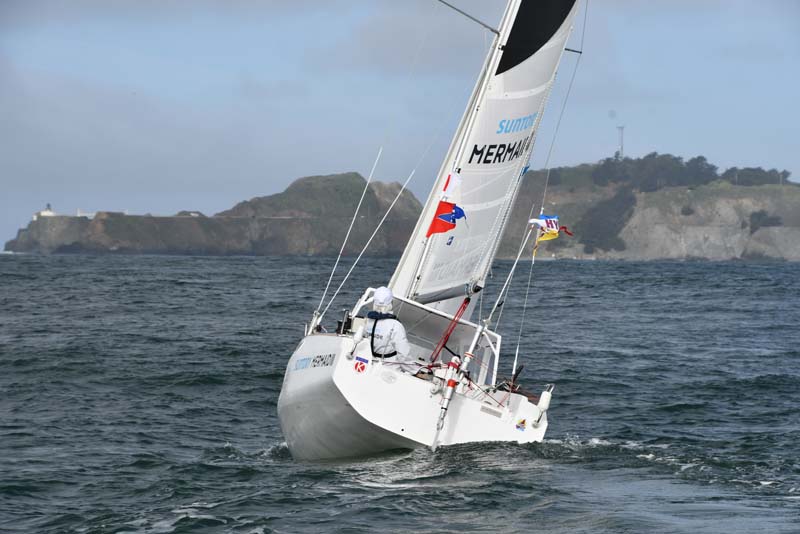
At the press conference, the solo sailor was asked what he was thinking about as he prepared to go. He apologized to the crowd, acknowledging it was a beautiful morning and he just wanted to leave and start sailing. So he put down the microphone and headed to the dock, and we hooked up a towline and off we went. A dozen or more boats came out to escort him under the Bridge. He gave everyone a wave and sailed away. We’ll be following him on the tracker, and hope everyone in Hawaii can give him a wave as he sails by. Then we’ll look forward to his arrival in Japan.
Vallejo Marina: Gateway to the Bay, Delta, and Napa River
40′ to 45′ foot slips are now available at $9.97/ft. www.ci.vallejo.ca.us
The Great Vallejo Race Turns 122 This Year
This year’s Great Vallejo Race promises to be bigger than in years past due to going back to its pre-pandemic normal dates of April 30-May 1, pent-up demand, and high registration levels for PHRF certificates. We will have our ‘Smoke on the Water’ BBQ stand open, along with our ‘Fun on a Bun’ burger bar. Our outdoor Tiki Bar will feature Mt. Gay rum drinks, Mare Island brews (official beer sponsor) and Thirty-Seven Wines (official wine sponsor). The steel drum band will begin at 2 p.m. on the outdoor patio. The party will really ramp up at 7 p.m. when the Darrel Edwards Lighting Up the Soul band will take the stage.
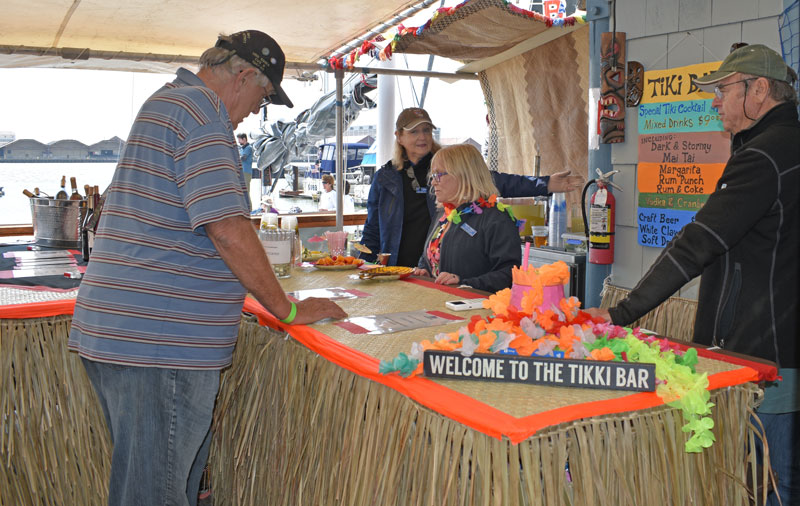
Vallejo Race History
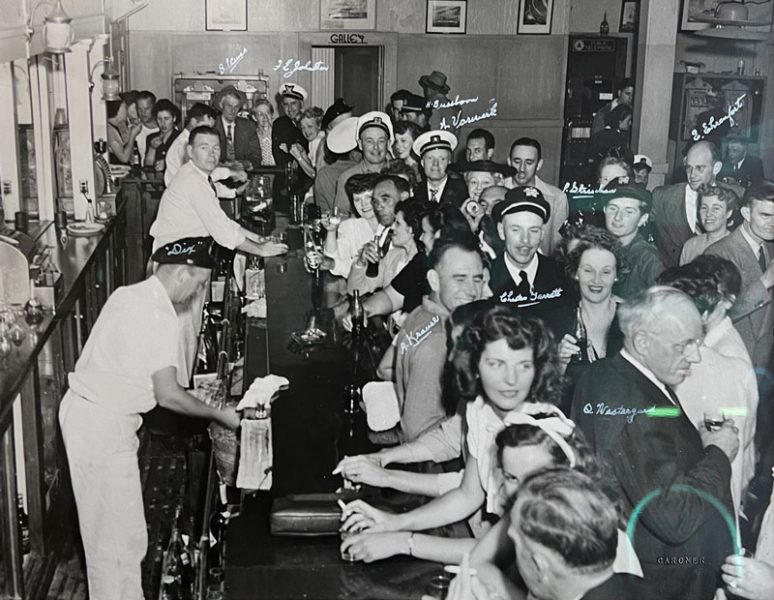
The first organized race to Vallejo was during the second weekend of July 1900. Sailboats from the San Francisco, Corinthian and California Yacht Clubs participated. Newspaper articles of the time stated that dozens of boats participated in the race, which started in Sausalito on Saturday. Many of the boats reached Vallejo in the early afternoon, and throughout the evening. The wind was out of the northwest with an almost all-day flood current. The trip from Sausalito took anywhere from three to four hours.
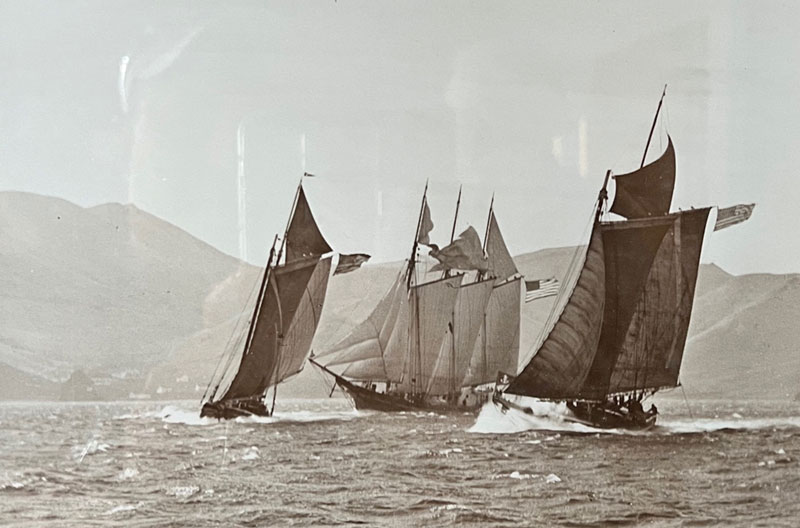
Some of the most famous boats on the Bay made the race in two different classes: 35-ft and above and 35-ft or under. Some of these boats were: Edna, Sappho, Mischief, Neriad, Spray, Arcturus, Harpoon, Nixie, Mignon, Amigo, Sans Souci and John Pew’s Truant. The Vallejoans of the Vallejo Yachting and Rowing Club welcomed the visiting crews on Saturday night with lively parties that included music and dancing. The clubhouse was under construction in 1900 and finished in 1902. Over the years, this has become the Great Vallejo Race, with between 200 and 600 boats participating annually.
The Vallejo Yachting and Rowing club formed on April 27, 1900, in response to the raising of ferry fares from Vallejo to Mare Island in 1898. Many commuters to the island disapproved of this action. They bought or made rowboats and sailboats for the crossing — the natural result being the rise of races to and from the island each morning and afternoon with each commuter vying to win. The Vallejo Yachting and Rowing club joined PICYA that same year (1900), the seventh club to join. Jack London was an early member of the club. He was said to have participated in several Great Vallejo Races during his time of membership.
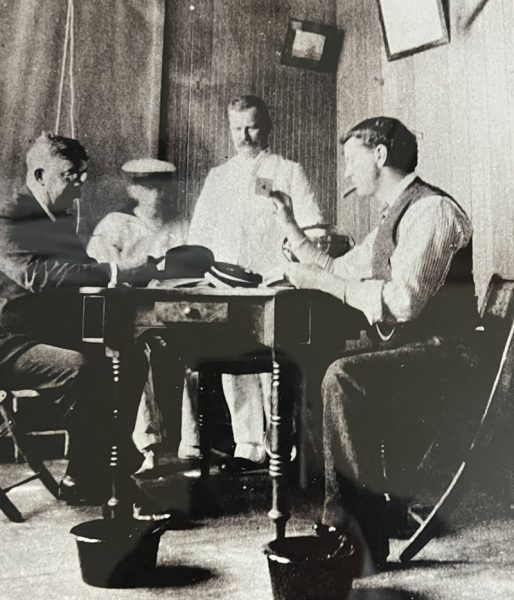
122 Years Later …
Today the Vallejo Yacht Club still hosts this historic race. It’s the season opener for the YRA’s in-the-Bay racing season. VYC is an all-volunteer club with a long reputation of warm hospitality and welcoming boaters and sailors of all types.
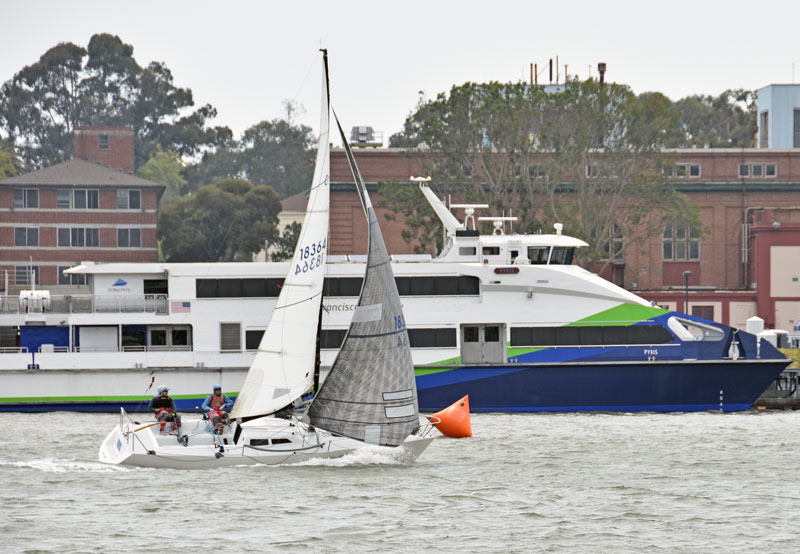
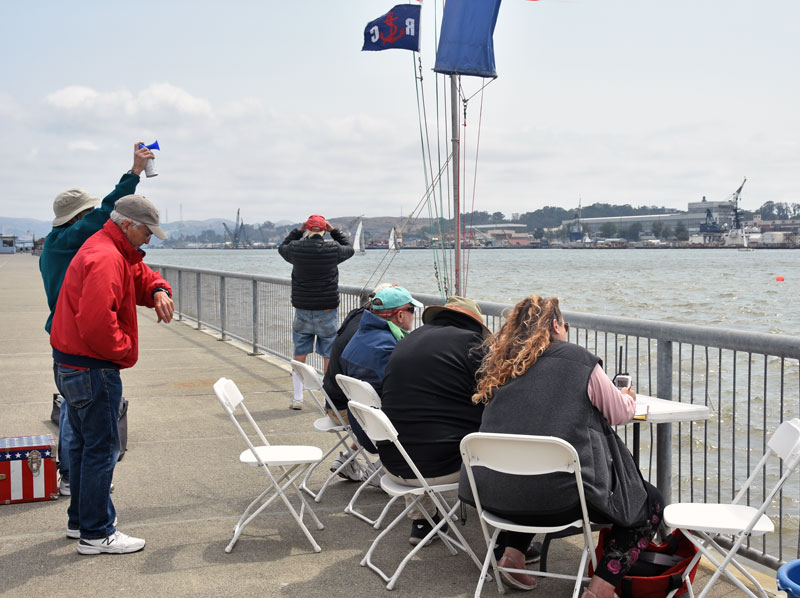
To register and pre-buy your dinner selections please go to www.jibeset.net/YRA000.php?RG=T009224946 or www.vyc.org/the-great-vallejo-race.
Sources: Vallejo Yacht Club the First 100 Years by Janet Evans, published April 2000; San Francisco Examiner, May 12, 1900.
Charlie Deist Takes an Impromptu Sail to Half Moon Bay
In the March issue Charlie Deist shares the story of when, together with his family and a friend, he took an unplanned left turn after sailing beneath the Golden Gate Bridge. You may remember Charlie from his story on learning to sail under the instruction of Darrell Allen Caraway.
As luck would have it, there was a full moon to light up the cockpit while Jesse cooked crab. We hadn’t planned to leave San Francisco Bay, so we didn’t bring our little hanging solar lanterns, or our pillows or pajamas, or even a change of clothes for that matter. Nor did we have a crab pot or anything that would even come close to fitting the Dungeness crabs — each over a pound — but Jesse improvised a steaming-hot death trap out of some heavy-duty aluminum foil, molded into a basin just deep and narrow enough to bring water to a boil inside the Magma grill on the stern rail. The last of the three crabs put up the biggest fight, suggesting he was the healthiest and tastiest, and sure enough, he was. Dipped in lemon and butter and washed down with cheap Portuguese red wine, these poor crabs were our rich reward for making it the 30 miles or so south from the Golden Gate on our ad hoc trip to Half Moon Bay.
Our crew included friend Jesse Selleck; my pregnant wife, Emma; our 2-year-old daughter, Clare; and me. We had planned to leave the day before, until a tsunami from a volcanic eruption halfway around the world caused a butterfly to flap its wings in Berkeley, or something like that. We arrived before sunup, but we couldn’t schmooze our way through the meter maid’s fortified barricade on University Avenue, which meant we couldn’t get our car and gear into the Berkeley Marina lot and onto Sun Kiss, our 1973 Islander 36. So we waited, and then waited some more, until we had mostly lost hope of sailing to Half Moon Bay — despite the long weekend — meaning it probably wouldn’t happen before the new baby was born, meaning when would it happen, actually?
Sunday came, and we modified our plans to just stick our nose out the Golden Gate and then go hiking on Angel Island. But we made such great time getting across the Bay, riding the ebb, that turning around against the quickening ebb seemed crazier than continuing on. So we kept going, redeeming our original plan, past crab pots and harbor porpoises, craggy cliffs and green buoys, until we reached the next safe harbor. The same journey that can take a full day of hellish sailing instead took just under seven hours because of 10- to 15-knot easterlies. We got up past hull speed, rocketing out on the last traces of the ebb, which wraps some distance around Seal Rocks and should not be underestimated in either direction. With our offshore wind, we hugged closer to the shore than was perhaps prudent. I turned left even before Red Buoy #8, the first channel marker to port upon exiting San Francisco Bay. This was against Emma’s better judgment, but she was distracted by 2-year-old Clare’s delight in watching the porpoises (“Dolphins!”) in our wake all the way past Lands End Lookout.
Here’s a video Charlie took during the sail south.
Read the whole story of Charlie, Emma, Clare and Jesse’s impromptu sail to Half Moon Bay at Latitude38.com.

